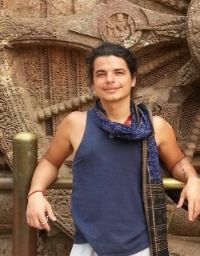Five interviews between Lilasuka and five of the main tour guides at Srila Prabhupada’s Palace of Gold.
TRIPAD VIBHUTI DAS
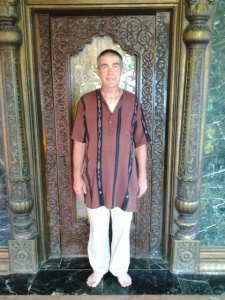
Tripadvibhuti das, long-time manager of Palace of Gold.
Lilasuka (L): We understand that you have managed Srila Prabhupada’s Palace here in New Vrindaban for a long time, Tripad prabhu. How long have you been giving tours here?
T: Since 1985.
L: What do you feel is the most important thing to tell visitors?
T: We cover many topics in the tours. But the three points I emphasize are: 1 you are not the body. 2 we make sure they hear the chanting of the holy name of Hare Krsna. 3. devotional service or serving god is the important goal.
It’s also very important that they leave the Palace thinking we’re normal people , not fanatics or crazies. Most people do leave thinking that.
L: What kind of questions have people asked you?
T: Oh, the usual stuff: why do the men shave our heads, what’s with the peacocks, what is that marking on the forehead. Occasionally if they’re more familiar with vedic culture, they’ll ask deeper questions.
Then, on maybe 5% of tours, westerners will ask about the pictures they see of Krsna’s pastimes, since most of them are not familiar with these.
L: What are some people’s comments that you hear?
T: It’s funny but even though we who work here at the Palace clearly see the repairs that are needed, visitors just don’t often see this. They come up here “ooo”-ing and “aaaaa”-ing! This Palace is really the greatest thing, in most of the visitors’ eyes. As a matter of fact, I was just walking past a couple of Americans outside yesterday, and despite the construction with new drainage and pipes going on, they are exclaiming, “This place is unbelievable. I’ve never seen such a beautiful place!” I remember them saying that even though there are problems here, it’s an unbelievable place!
L: Do you have any stories you would like to share?
T: Once on a tour these two older ladies were in the back hallway, when suddenly from the corner of my eye I saw something small dart across the hall. When I checked it out, I saw that there was a raccoon in the office. As soon as I informed the ladies, they freaked out and left immediately. I ran back and was luckily able to chase the raccoon outside. It actually stayed out there for a couple of days and looked kind of rabid.
L: What is your favorite thing about the palace that has kept you going for almost 30 years here?
T: You get to tell people about Krsna and Srila Prabhupada, and that is very enlivening. The high point of any tour is when you get questions. Sometimes their questions pleasantly surprise you. Once someone came and I don’t know if he was a local from West Virginia, or a hippy or who he was, but I sure didn’t suspect that he knew anything about Krsna or Prabhupada, but then he asked a powerful question about Lord Nrsimhadeva.
Srila Prabhupada’s Palace is a great place to be!
CHAITANYA BHAGAVAT DAS

Chaitanya Bhagavat das
L: How long have you been doing tours at the Palace, Chaitanya Bhagavat prabhu?
CB: Nine years now.
L: What is the most important thing that you want to convey to the visitors?
CB: I like to emphasize three things: 1.that we are all soul, not the body, and that real happiness doesn’t come just in relation to the body. To understand this, we have to stay in close touch with God and godly people. 2. that this world is not our real home. 3. that chanting the name of God is the best way to associate with God.
I also like to talk about the cows, with whom I work a lot.
L: Really? What do you tell people about cows?
CB: Humans are meant to eat plants. I talk about vegetarianism. I tell them that cows are Krsna’s favorite animal. I say how cows are affectionate and they are meant to be protected and cared for, just like everyone else.
L: What kinds of questions do the visitors ask?
CB: Many people pick up very quickly that Srila Prabhupada was a very special person and that we love him very much. So they ask about him. A lot of people ask if he ever lived here. They also ask about reincarnation when we get to the “changing bodies” exhibit. I like to explain that we are not so different from other religions. We are eternal souls and the reason we came to this earth is because we have individual free will, because things are based on the concept of love. Love can only come about by individual choice. So the Lord creates this material world, where we can choose to either love Him or not. These are universal principles. This is not sectarian. I ask them, “Isn’t this what Jesus also taught?” People like that.
L: What’s your favorite thing about giving tours?
CB: Connecting with people. We often have this arrogant attitude that “I am giving THEM Krsna.” But Krsna works through these people too.
For example, I’ll tell you a story about this really nice, neatly dressed couple, a man and a woman, who came during a raging blizzard. They told me, “We had a coal miner friend. His dying wish was that we come here and visit the Palace of Gold. He said that he had had the most amazing religious experience here.”
So I started the tour. As soon as we got down to the end of the hallway to Srila Prabhupada’s lotus footprints in concrete under the glass panel, suddenly the man (who was a minister by the way) looks wide-eyed, at me. He shouts out, “THE FEET OF A PROPHET!” Then his wife, also a minister, immediately lays her head on Prabhupada’s feet and begins offering prayers. Her husband asks me, “Do you know why the feet of a prophet are worshipable? Because they go from town to town preaching the gospel of the Lord!”
I was amazed. The verse “prithivite ache yada nagaradi grama” came to mind. Prabhupada himself declared, “Prthivite, all over the world, as many towns and villages are there, Sri Caitanya Mahaprabhu predicted that His mission will spread. This prediction was made by Caitanya Mahaprabhu personally five hundred years ago.“
When the tour was finally over, we hugged and they left in the snow. You become renewed in your Krsna consciousness and in appreciating the Palace when things like this happen.
L: Thank you.
PARAMDHAMA DASI
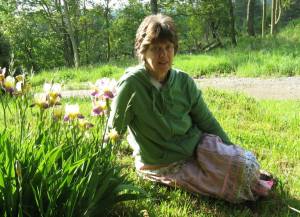
Paramdhama dasi
L: Paramdhama, we understand that you’ve been working at Prabhupada’s Palace of Gold for over 30 years. Is this correct?
P: I guess that’s right. I love it here. But I’ve only really been giving tours for the last eight or nine years.
L: You must have some stories to tell.
P: Recently, a visitor came to the Palace on his way from Baltimore to Las Vegas. I teased him, ‘Don’t you think it’s a little unusual that you’re stopping at the memorial of a saintly man on your way to a gambling place?’ He told me that he was stopping here to get some protection from the sinful lifestyle prominent in Las Vegas.
L: How do visitors react when you talk about the “changing bodies” exhibit photo that is up on the wall? I think sometimes there are opposing reactions.
P: Yes. One person blurted out, emphatically, “NO!” Like “wait a minute – back up here”. A lot of people just listen and don’t say anything. Some people nod their heads, as if they’re intrigued by what I’m explaining. Others sometimes will even go up to the picture and jokingly comment, “So that’s me over there,” as they point to either a young man, middle-aged man or old man.
L: You must have fun with that. What do you think is the most important thing to emphasize?
P: I feel it’s very important to show them the chanting on beads. I try to first explain how we are not this body, and how we need to accept a spiritual master in order to make real progress in our lives, and then I emphasize the importance of chanting Hare Krsna, which is the highest instruction given by the spiritual master.
L: What do you like about giving tours?
P: I like to find out about how people heard about the Palace. If they are really interested, I like to give them one of Srila Prabhupada’s books.
L: What kind of questions do people ask?
P: Where did we get the money? I tell them donations. They also are curious about the tilak that we wear. Surprisingly, there is this guy from Washington, PA who rides a motorcycle and comes here to visit every year. You would be surprised by what kind of people come back here for repeat visits.
L: Anything else you’d like to share?
P: Whenever I take people in Prabhupada’s study, I like to briefly explain, “These books you see here that Prabhupada translated and gave to us are very important. And, most importantly, Prabhupada recommended that we chant on these beads.” Then I repeat the maha mantra and chant for a while.
JAYA MUKTI DAS aka BHAKTA TOM
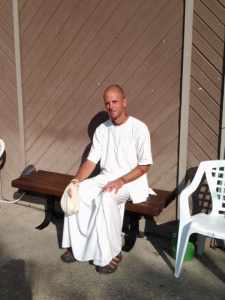
Jaya Mukti das aka Bhakta Tom
Lilasuka (L): When did you start giving tours at Prabhupada’s Palace of Gold, Jaya Mukti prabhu?
JM: Five years ago.
L: And what do you feel is the most important thing to tell people on a tour?
JM: Well, I like to put emphasis on different things according to the people on the tour and their particular interests. There are such topics as the building and its architecture, there’s the philosophy of Krsna consciousness, there’s Srila Prabhupada, the person, there’s the community and how we work together. Of course, if it’s a mixed group, I touch on each of these subjects, in order to keep everyone’s interest.
L: What are the kinds of questions that people ask?
JM: One popular question is: If Srila Prabhupada was a renunciate, why such a grandiose building? So I’ll tell them the analogy about a small child making a nice picture for his grandparents. He wants to use all the crayons in the box, and fill in the whole page so it’s the very best picture he can create. Well, when we get donations for Prabhupada, we want to use them to create the very best thing we can for him since he is so important in our lives.
L: What kind of comments do people make?
JM: People comment on the murti (statue) of Srila Prabhupada in the study, and how real he looks. And once, when I described how the beautiful Ming Dynasty vases in the study are from China, one little nine year old boy commented, “So what? I’ve got lots of stuff from China!”
L: What do you like about giving tours?
JM: Connection with people! I’ve met so many nice people giving tours here and I’ve even stayed in touch with some of them. I’m always curious about why they came, and where they are from. The transmigration picture in the back hallway is an important tool that I use to explain the gist of our philosophy.
L: Do you have any stories you can tell us about the guests?
JM: Sure. Two things: once a young woman from Cameron almost went into labor at the changing bodies exhibit (ironically)! They rushed her to the hospital, but it was false labor. She came back the following week to finish her tour!
And one time there were these tough bikers on a tour. When I mentioned that Srila Prabhupada, a holy man, went to preach in the bowery of New York City, the apparent leader of the bicycle gang couldn’t get over that Srila Prabhupada, a real holy man, had actually lived in the bowery!
SADARUCI DAS
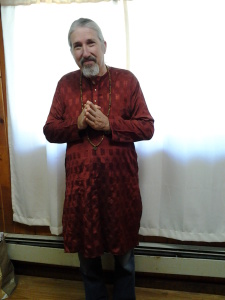
Sadaruci das
Lilasuka (L): Sadaruci, I understand that you used to give tours at the Palace at the beginning of the 21st century, back in 2001.
Sadaruci (S): That’s right. And I even gave tours farther back than that, when I lived here in NV from 1995-2001.
L: That’s cool! And now that it’s 2014, what is your connection with the Palace of Gold?
S: Well, beginning in April of this year, I’ve been giving Palace tours five or six days a week.
L: It sounds as though you’ve conducted a lot of tours here at the Palace. What do you like about giving tours?
S: I get to talk about Srila Prabhupada all day! For a devotee, what can be more blissful than that?
L: That’s for sure! What do you feel is the most important thing you can tell the visitors?
S: That everyone needs a guru. Lord Krsna had a guru. Lord Caitanya had a guru. Srila Prabhupada also had a guru. A guru is necessary in order to be successful in your spiritual life. I emphasize that.
L: How does a typical tour go?
S: I start by introducing Srila Prabhupada and his history of coming to America back in the ‘60’s, during the height of the hippie movement when everyone was looking for peace, love and happiness. Prabhupada himself gave the peace formula: “chant and be happy”.
L: How do people react to hearing that?
S: I’ve seen many people have life changing experiences coming to Prabhupada’s Palace. There are a variety of reasons. For instance, when I explain the “changing bodies exhibit”, it opens many people’s eyes to the fact of life after death. Many people didn’t understand that. But they can see the progression of life. I tell them that they have a chance to change their destiny for the better. I tell them they don’t have to take another birth, and that they can actually go back to the spiritual world. A lot of people are fascinated. I encourage people that no matter what religion they are following, if they just add the chanting of Hare Krsna, they will make rapid advancement spiritually.
L: I see. Anything else?
S: Well, I think it’s important to convey the message of hope for the future – everyone’s future – if they can take to some spirituality.
L: So what do you think is the importance of the Palace of Gold to the NV Community?
S: I think it is the Palace that is the magnet that draws people to NV. Some of them don’t even go down the hill to visit the temple, but they still get a lot of information and a great impression by just taking a Palace tour. I feel that the more we restore and improve the Palace, the more good things will happen here in NV.
L: Do you have a final message?
S: Yes! If you’re not too busy, come and pick up a shovel or a paint brush. We have lots of work to do here and we can sure use your help.
END
 May the glorification of the transcendental name, form, qualities and paraphernalia of the Supreme Personality of Godhead protect us from the influence of bad planets, meteors, envious human beings, serpents, scorpions, and animals, like tigers and wolves. (Srimad-Bhagavatam, 6.8.27) Read more ›
May the glorification of the transcendental name, form, qualities and paraphernalia of the Supreme Personality of Godhead protect us from the influence of bad planets, meteors, envious human beings, serpents, scorpions, and animals, like tigers and wolves. (Srimad-Bhagavatam, 6.8.27) Read more ›  May the glorification of the transcendental name, form, qualities and paraphernalia of the Supreme Personality of Godhead protect us from the influence of bad planets, meteors, envious human beings, serpents, scorpions, and animals, like tigers and wolves. (Srimad-Bhagavatam, 6.8.27) Read more ›
May the glorification of the transcendental name, form, qualities and paraphernalia of the Supreme Personality of Godhead protect us from the influence of bad planets, meteors, envious human beings, serpents, scorpions, and animals, like tigers and wolves. (Srimad-Bhagavatam, 6.8.27) Read more ›  Indradyumna Swami: Yesterday we visited Pavana-sarovara, a sacred lake near Nandagram. Our program was the same as everyday; hearing and chanting the glories of Lord. Such sravanam and kirtanam seems to be especially potent in the holy dhama. Local tradition says that the results of any spiritual practice done in Vrindavan dhama is magnified a thousand times. Perhaps that's why Srila Prabhupada often encouraged his disciples to come visit these sacred places and return to their country's of birth purified and ready to share their good fortune with others.
Indradyumna Swami: Yesterday we visited Pavana-sarovara, a sacred lake near Nandagram. Our program was the same as everyday; hearing and chanting the glories of Lord. Such sravanam and kirtanam seems to be especially potent in the holy dhama. Local tradition says that the results of any spiritual practice done in Vrindavan dhama is magnified a thousand times. Perhaps that's why Srila Prabhupada often encouraged his disciples to come visit these sacred places and return to their country's of birth purified and ready to share their good fortune with others.  I do not accept many different meanings for the holy name of Krishna. I know only that Lord Krishna is Syamasundar and Yasodanandana. That's all I know. (Sri Caitanya-caritamrta, Antya-lila, 7.85)
I do not accept many different meanings for the holy name of Krishna. I know only that Lord Krishna is Syamasundar and Yasodanandana. That's all I know. (Sri Caitanya-caritamrta, Antya-lila, 7.85) 
 The true acarya presents Krishna to everyone by preaching the holy name of the Lord throughout the world. Thus the conditioned souls, purified by chanting the holy name, are liberated from the blazing fire of material existence. (Sri Caitanya-caritamrta, Antya-lila, 7.12)
The true acarya presents Krishna to everyone by preaching the holy name of the Lord throughout the world. Thus the conditioned souls, purified by chanting the holy name, are liberated from the blazing fire of material existence. (Sri Caitanya-caritamrta, Antya-lila, 7.12)  When loud chanting of the Hare Krishna mantra is performed all over the world by those who follow in Your footsteps, all living entities, moving and nonmoving, dance in ecstatic devotional love. (Sri Caitanya-caritamrta, Antya-lila, 3.72)
When loud chanting of the Hare Krishna mantra is performed all over the world by those who follow in Your footsteps, all living entities, moving and nonmoving, dance in ecstatic devotional love. (Sri Caitanya-caritamrta, Antya-lila, 3.72)  My Lord, the moving entities who have heard Your loud sankirtana have already been delivered from bondage to the material world, and after the nonmoving living entities like trees hear it, there is echo. (Sri Caitanya-caritamrta, Antya-lila, 3.70)
My Lord, the moving entities who have heard Your loud sankirtana have already been delivered from bondage to the material world, and after the nonmoving living entities like trees hear it, there is echo. (Sri Caitanya-caritamrta, Antya-lila, 3.70)  I'll be the first to tell you I don't know much about these guys. But I did know the feeling I got when I was in their presence. All I could feel was absolute joy. This is a quick edit but plan on going back at the next UF Game to get a whole but of different shots and angles to do another edit.
I'll be the first to tell you I don't know much about these guys. But I did know the feeling I got when I was in their presence. All I could feel was absolute joy. This is a quick edit but plan on going back at the next UF Game to get a whole but of different shots and angles to do another edit. 





